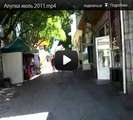Vorontsov's palace in Alupka, Crimea
Crimea, the city of Alupka Alupka park shooting in September 2010. Alupka Park is the natural reserve fund of Ukraine and is a monument of landscape architecture, is protected by law.
Camera: Panasonic HDC-HS700, Music: Above the Clouds. Artist: Ulrich Schnauss and Jonas Munk
Vorontsov Palace
At the foot of Mount Ai-Petri, in the heart of Alupka, majestic Vorontsov Palace, located in the green of the ancient magnificent park. Vorontsov Palace - is a unique architectural monument, built in the first half of the XIX (nineteenth) century. The palace was built in the era of Romanticism, and literally affects their vivid variety of architectural forms and styles. Vorontsov Palace in combination as the original layout of its body, and also interesting style solutions for each of them. Vorontsov walls lined with such skill and craftsmanship that this unique work is just incredible. Decorating the interior of the Palace of delights for generations connoisseurs.
Over construction of the Palace of the work of hundreds of civilian workers and serfs - masons, carvers, modeler, carpenters - they put their work here, and all the talent. During the construction of the Palace was so skillfully used the terrain that, looking at it, it seems like the Palace literally grows out of the natural environment, merging with the majestic Mount Ai-Petri.
The palace was built as a summer residence of the governor-general of the Novorossiysk Territory and a prominent statesman of the Russian Empire, Mikhail Vorontsov (1782 - 1856 years of life). Despite the fact that the palace was built by the famous English architect Edward Blore (1789 - 1879 years of life), he Blore to Alupka came. The architect was well aware of the local terrain, in addition, the very foundation and even the first masonry niche central building were laid. The fact that the original palace built by starting another project - designed by architects Thomas Harrison and Francesco Boffo.
English Romanticism first half of the XIX (nineteenth) century, there was great enthusiasm from ancient monuments, their study and restoration. It was this work and devoted all his youth architect Blore. Blore later became the court architect of George IV (fourth), and later Queen Victoria. That he owned the majestic Westminster Abbey projects, as well as part of the facade of Buckingham Palace, some manor building, both on the continent and in the former British colony of Australia. For example, he owns a project of the Government House in Sydney, Australia. But perhaps the most complete and the great gift of the architect is revealed in the project Alupka Palace!
As we have already mentioned, the original palace was built in Alupka on another architectural project: the work done on it since 1825 (one thousand eight hundred and twenty fifth) until 1828 (one thousand eight hundred and twenty eight) years, Odessa architect Francesco Boffo. It should be noted that Francesco Boffo already built to Vorontsov Palace in Odessa. Also in the design intent of Alupka Palace and attended English architect Thomas Harrison.
According to the original project, the Palace had to be done in the classical style, and since January 1829 began the first preparations. But all of a sudden in June 1831 by Vorontsov, who was at that time in England, received an order to stop construction. Apparently, the customer was able to feel the changes that have taken place in the attitudes and tastes of society during that time. In addition, Vorontsov probably want to add a variety of pavilions and houses a palace English "gothic style", despite the fact that the palace itself, in its conception embodied different historical styles.
That turned out to be an architect Blore, who was able to satisfy the desire of the customer. In just one year Blog fulfilled the order, and in December 1832 began re-erection of buildings of the Palace is a new project. Despite the fact that Blore to Alupka not arrived, the Palace was built under the supervision of England sent an assistant architect William Blore and Gunta. The original foundation and already erected, masonry deep portal niche included in the new project. The very same project Blore essentially and fundamentally different from the original draft. This was the building of a completely new, previously unknown, compared to classicism architectural principles.
Instead of the original - a geometrically rigorous grouping buildings - Blore housing arranged from west to east on the movement of the mountains, which is organically entered the Palace of the existing natural landscape. It is thanks to the successful designing buildings, the Palace could find its like nothing on earth expressive image. In the Palace of the body to the chassis surprisingly colorful handed presentation of the development of medieval architecture, from its earliest forms and ending XVI (sixteenth) century. Emphasis was placed precisely on the English version of architecture.
The main entrance to the Palace is located on the west side, and here we see a typical feudal castle-fortress VIII - XI (eighth - eleventh) century. Round watch towers, monumental towering over who enters the Palace, deaf solid wall, rather closed space - travel. That's what made the courtyard, where the economic case, but all of a sudden, this austere medieval passage leads to the main building of the Palace. In the main building we see a high crenellated walls, rough masonry, and slit-like window-slits create a sense of inaccessibility of the Palace. Only a beautiful suspension bridge, which marks the band in the front dining room, brings in this harsh medieval atmosphere unexpected lyrical note.
The further we move from the western entrance to the Palace, the greater will be showing signs of architecture beyond. So, in the ceremonial courtyard after feeling closed suddenly a flow of light and a gust of wind - offers amazing beautiful landscapes with the top of Mount Ai-Petri, that seems built in in this architectural style. On the one hand we see the clock tower, and on the other hand - the eastern wing, and between them - an amazing Mount Ai-Petri. At the bottom, we can observe the scenery, which is limited to the supporting wall of the palace with a fountain in the center. Wide eyes, the windows looking at the majestic park northern facade of the main building of the Palace. It is this body most Tudor style shows, which was typical of England XVI (sixteenth) century.
Most important ornamental decoration of the Palace - it is flat, horseshoe, pointed arch - it is repeatedly in a cast-iron balustrade balconies and carved in the stone lattice, which protects the roof. Even in the decoration of the south entrance portal, which is decorated with oriental splendor, traced this decorative motif.
The two-storey arch horseshoe cancer, amazing carved itself a niche in the plaster, which intertwine Tudor flower paintings and drawings of the Lotus, these motifs are completed six-fold repetition of the phrase in Arabic: "There is no victor but Allah." The fact that the image of the Palace rather strongly influenced by passion XIX century - at the time were equally popular as chivalrous novels of Walter Scott, and the wonderful Arabian tales.
If you remember that it was in 1830-ies (eighteen hundred and thirty) years in Russian were translated "Ivanhoe" Scott and "Alhambra" Irving, it becomes clear why the title of the Palace of the Alhambra, which lived in the Spanish caliphs XIV (fourteenth ) century, suddenly appeared in Alupka. Of course, the architect was not trying to imitate anyone's else style - rather in the Vorontsov Palace fits over a lot of different ages, but most importantly it was an amazing imitation of a local nature. It is an organic unity of the Palace with a beautiful, changing, romantic and mysterious nature of the Crimea, and is an example to generations of architects. Palace forms merge organically with the surrounding nature and surprisingly complemented pattern of Mount Ai-Petri.
If you raise your eyes from Alupka, the mountain Ai-Petri recalls the "ruins" of the medieval Gothic castle. It is these natural scenic "ruins" and the basis for many landscape architecture and park Vorontsov.
The main building blocks in the construction of the Palace was diabase magmatic origin. Diabase with a greenish-gray color to match the color became mountains and evergreen vegetation. Sam was taken close to the building material - of the many natural deposits in Alupka. Even for the basement of the palace served as part diabase rocks!
Diabase - it is a solid rock in nature, it is almost two times harder than granite, but very capricious in processing. One wrong blow hammer master - and virtually all of the work was in vain. Despite this, of the huge misshapen lumps carved flat wall blocks and even very complex in their drawings decorate the walls! For interior decoration diabase carefully polished. It's hard to believe, but in XIX (nineteenth) century, all these complex works were carried out by hand and only primitive tools.
In the summer of 1848 (one thousand eight hundred and forty eight) at the central staircase, which leads to the main entrance to the Palace, set sculpted figures of lions, which were made in the workshop of the Italian sculptor Giovanni Bonnani. The final touch in the Palace was made - the lion terrace superbly completed the construction and design of the Ensemble Vorontsov.
![]()





No comments:
Post a Comment